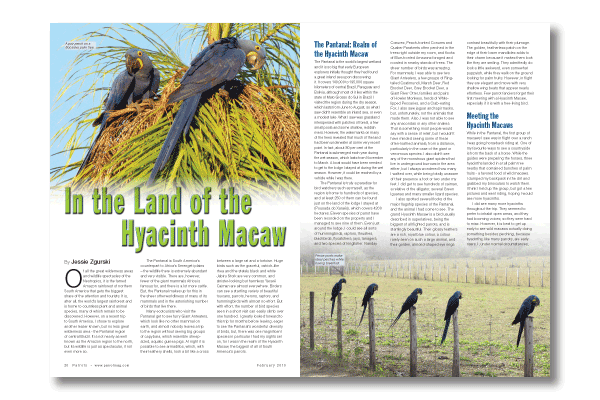Jessie Zgurski
Of all the great wilderness areas and wildlife spectacles of the Neotropics, it is the famed Amazon rainforest of northern South America that gets the biggest share of the attention and tourists. It is, after all, the world’s largest rainforest and is home to countless plant and animal species, many of which remain to be discovered. However, on a recent trip to South America, I chose to explore another lesser known, but no less great wilderness area - the Pantanal region of central Brazil. It is not nearly as well known as the Amazon region to the north, but its wildlife is just as spectacular, if not even more so.
The Pantanal is South America’s counterpart to Africa’s Serengeti plains – the wildlife there is extremely abundant and very visible. There are, however, fewer of the giant mammals Africa is famous for, and there is a lot more cattle. But, the Pantanal makes up for this in the sheer otherworldliness of many of its mammals and in the astonishing number of birds that live there.
Many ecotourists who visit the Pantanal get to see furry Giant Anteaters, which look like no other mammal on earth, and almost nobody leaves a trip to the region without seeing big groups of capybara, which resemble sheep-sized, aquatic guinea pigs. At night it is possible to see armadillos, which, with their leathery shells, look a bit like a cross between a large rat and a tortoise. Huge birds such as the graceful, ostrich-like rhea and the stately black and white Jabiru Stork are very common, and sinister-looking but harmless Yacaré Caiman are almost everywhere. Birders can see a startling variety of beautiful toucans, parrots, herons, raptors, and hummingbirds with almost no effort. But with effort, the number of bird species seen in a short visit can easily climb over one hundred. I greatly looked forward to this trip for months before leaving, eager to see the Pantanal’s wonderful diversity of birds, but, there was one magnificent species in particular I had my sights set on, for I was in the realm of the Hyacinth Macaw, the biggest of all of South America’s parrots.
Read more in the magazine…

